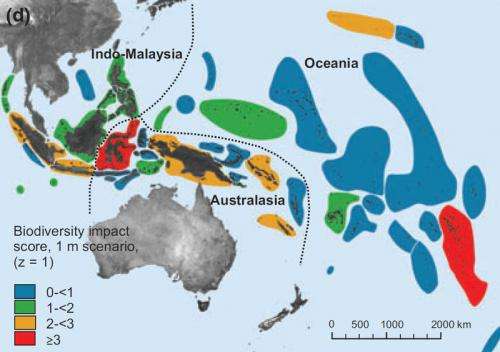Sea level rise: Jeopardy for terrestrial biodiversity on islands

Model calculations predict a sea level rise of about one meter by the end of this century and of up to five and a half meters by the year 2500. Until now there are few studies on the potential impacts of a rising sea level on biodiversity. Florian Wetzel and colleagues of the University of Veterinary Medicine, Vienna together with Walter Jetz of Yale University, USA have now published modelling results for the Southeast Asia and Pacific regions. Their results show that many terrestrial vertebrates are vulnerable to sea level rise and the risk of extinction is highest for endemics found only on certain islands and already endangered species. Their findings are published online in the journal Global Change Biology.
Terrestrial species on low-lying islands and coastal regions are vulnerable to sea level rise due to climate-change, the most vulnerable species being endemics with limited ranges and rare species that are endangered already. That is the key message of a study by Florian Wetzel and colleagues of the Konrad Lorenz Institute of Ethology (KLIVV) of the University of Veterinary Medicine, Vienna (Vetmeduni Vienna) and Walter Jetz of the Department of Ecology and Evolutionary Biology at Yale University, USA.
The new study is the first of its kind in terms of geographic scope as it covers the entire Southeast Asian and Pacific region with more than 12,000 islands and the distribution of more than 3,000 vertebrate species (birds, amphibians, reptiles, and mammals). It is also the first study to use data in the high spatial resolution of 90 metres to address this problem. Compared to previous research the predictions therefore are particularly accurate. "The high data quality with which we were able to work constitutes a quantum leap of precision", explains co-author Helmut Beissmann of KLIVV.
The model calculations show how islands and atolls in the study region will lose large parts of their land area and also that some islands will even become completely submerged. Wetzel and his colleagues predict that even with a sea level rise of one metre which is expected within the current century, one per cent of the land mass of the study area will be lost on average. Many Pacific islands lie only a few metres above sea level today, and a sea level rise of just one meter would translate into a loss of close to four per cent of their land area. What was surprising to find was the enormous variation in the vulnerability of different island groups. "Some Pacific atolls stand to lose one third of their land area with sea level rise of just one meter, and the species living there would be seriously at risk", explains study author Florian Wetzel. "In contrast, other volcanic island groups and their resident species will incur area losses of just a few per cent."
Should sea level rise reach six metres by 2500, Pacific islands could lose 14.5 per cent of their current land area and the overall loss for the region would average around 9.3 per cent, which is a significant loss of habitat. Some of the islands will become completely submerged and even with a rise of one metre, 14.7 per cent of all islands in the study area would disappear under water. However, it is important to note that only very small islands will be completely inundated. "This enormous number of entire islands lost is the most stunning result of our study", says Dustin Penn, head of KLIVV and co-author of the study.
Once the researchers determined which areas would likely be lost, they then assessed which species are the most vulnerable to sea level rise. To assess the consequences that rising sea levels could have for terrestrial vertebrate species the researchers calculated a biodiversity impact score for the island species in the study area. Their results show how the loss of habitat that goes along with losses of land area constitutes a serious threat to the continued existence of endemic vertebrate species in some of the Southeast Asian and Pacific islands. They discovered that endemic species – found nowhere else but on certain islands – and species that are already endangered face the greatest area loss from sea level rise. Their findings raise concerns not only about theses individual species but also the global impact of sea level rise for island and coastal species.
The scientists´ results once again confirm the potentially worrisome consequences of climate change. Moreover, the authors explain why their results may underestimate the risks and provide a series of additional factors could make the situation even worse for island biodiversity. For example, shifts in the settlement areas of the local human residents due to sea level rise could lead to further habitat reduction for terrestrial vertebrates. The researchers therefore recommend taking sea level rise into account when planning species conservation measures in the affected areas.
The article "Vulnerability of terrestrial island vertebrates to projected sea level rise" by Florian T. Wetzel, Helmut Beissmann, Dustin J. Penn and Walter Jetz appeared in the journal "Global Change Biology" online ahead of print.
More information: dx.doi.org/10.1111/gcb.12185
Journal information: Global Change Biology
Provided by University of Veterinary Medicine -- Vienna















